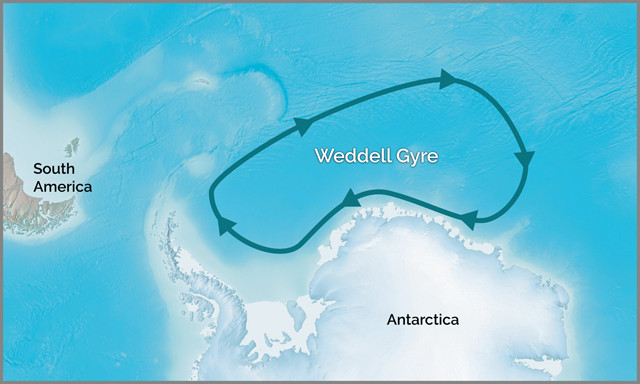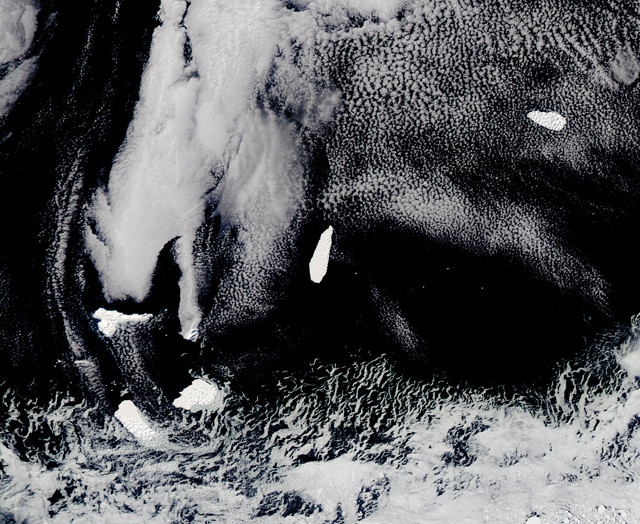
by Kate S. Zalzal Thursday, March 8, 2018

In the Weddell Sea Gyre, one of two clockwise-spinning circulation patterns in the Southern Ocean, warming has accelerated the spinning. Recent research suggests this acceleration — and the warmer, faster-moving Antarctic Circumpolar Currrent and Circumpolar Deepwater that result — may trigger the development of smaller, shorter-lived polynyas like those observed over the past two years. Credit: K. Cantner, AGI.
In addition to polynya formation and warming-induced surface freshening, other factors may also impact open-ocean convection in the Southern Ocean. The warming atmosphere is shifting global climatic zones and their associated wind fields poleward in both hemispheres. In the Weddell Sea Gyre, one of two clockwise-spinning circulation patterns in the Southern Ocean, this shift has resulted in a dramatic increase in wind stress curl (the strength of the wind’s influence on ocean water flow) over the past two years.
Casimir de Lavergne, a postdoctoral researcher at the University of New South Wales in Australia, and others suggest that a positive Southern Annular Mode (SAM), a north-south oscillation of the westerly wind belt in the Southern Hemisphere, will decrease the likelihood of a giant open-ocean Weddell polynya forming by affecting freshwater inputs and thus increasing upper-ocean stratification. But this acceleration of the gyre — and the warmer, faster-moving Antarctic Circumpolar Current (ACC) and Circumpolar Deepwater that result — may trigger the development of the smaller, shorter-lived polynyas over Maud Rise like those observed over the past two years, says Arnold Gordon, an oceanographer at Lamont-Doherty Earth Observatory.
Bottom-water outflow from the Weddell Sea has also freshened significantly in recent years, and this too may be linked to the strength of the Weddell Gyre, he says. Gordon speculates that the changes that have prompted the recent Maud Rise polynya may help precondition the Weddell Sea for another massive polynya. “It’s possible that we’re seeing quite a regime shift in the Weddell Sea,” he says.

Four icebergs of various sizes and ages are visible in this Oct. 20, 2017, image of the Southern Ocean, in the Weddell Sea (bottom/south) and the Drake Passage (top/north) near Elephant Island (left middle, south of largest cloud mass). These icebergs were carried to their present location by a combination of the coastal countercurrent, which flows counterclockwise close to Antarctica, and the Weddell Sea Gyre, which spins clockwise and pushes the bergs in the western Weddell Sea to the north. Credit: NASA image by Jeff Schmaltz, LANCE/EOSDIS Rapid Response.
Like in the Weddell Sea Gyre, wind fields around the world appear to be shifting poleward and intensifying in response to global warming, which impacts surface ocean currents. But the data aren’t consistent everywhere, particularly for western boundary currents, the warm, deep, narrow and fast-flowing currents that form on the west side of an ocean basin and carry warm tropical water poleward. In a study published in Nature in 2016 that analyzed water column and satellite data, Lisa M. Beal and Shane Elipot, both oceanographers at the University of Miami, found that the Indian Ocean’s western boundary current, the Agulhas Current, is getting wider rather than strengthening under the intensifying winds.
“Currently, western boundary current regions are warming at three times the rate of the rest of the world ocean, and our research suggests this may be related to a broadening of these current systems,” said Beal in a statement. The researchers noted that data from other western boundary currents, such as the Kuroshio and East Australian currents, hint at similar trends. Broader and more turbulent boundary currents may prompt greater mixing between the continental shelves and open ocean, and thus could lead to greater upwelling and productivity and a decrease in poleward heat transport — another way that carbon and heat storage may change in response to ocean and atmospheric warming.
© 2008-2021. All rights reserved. Any copying, redistribution or retransmission of any of the contents of this service without the expressed written permission of the American Geosciences Institute is expressly prohibited. Click here for all copyright requests.